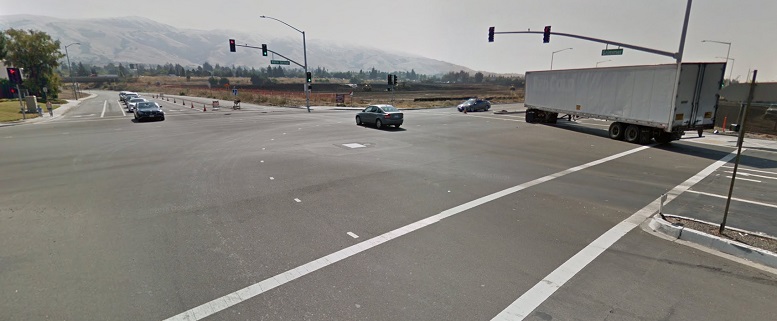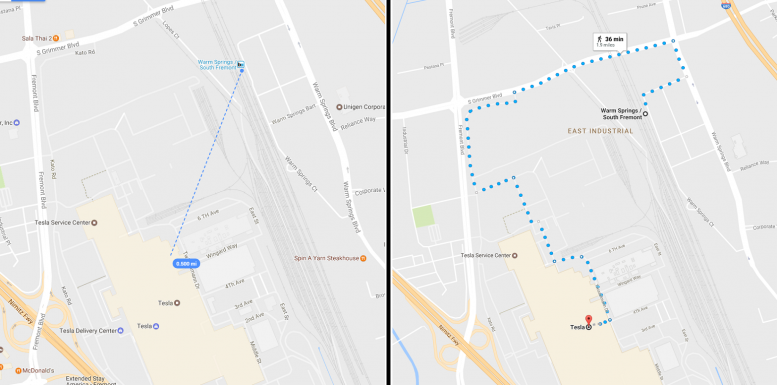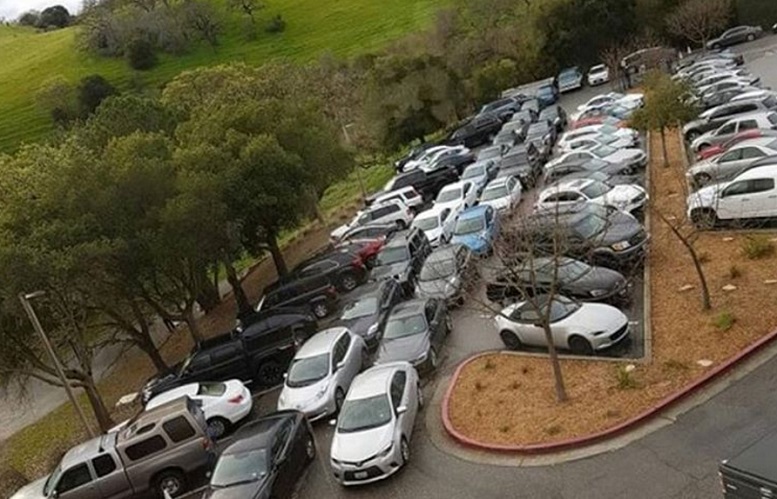Investor and entrepreneur Elon Musk has put forth some radical transportation proposals (Hyperloop, anyone?), but when it comes to solving day-to-day commuting challenges, the Tesla CEO seems to be fresh out of new ideas. The Wall Street Journal reported this week on the parking crunch at two of the company’s facilities in Silicon Valley:
“Parking is, like, one of my biggest nightmares—like, where do we park everyone?” said the Tesla Inc. chief executive, on a recent earnings call with analysts who were trying to probe concerns about the electric-car maker’s year ahead.
At Tesla’s Palo Alto, Calif., headquarters, uniformed valets dashed about on a recent morning directing traffic and cramming in as many cars as possible. A bumper-to-bumper formation of parked cars snaked through the lanes of the lot, boxing in other vehicles.
At the Tesla factory 30 miles away in Fremont, which has 6,000 employees over the course of various shifts competing for 4,500 vehicle spaces, photos show parking is a free-for-all. Cars are jammed diagonally in spots, propped up on curbs or resting on gravelly medians.
Instead of asking “where do we park everyone,” Musk really ought to take a step back and ask, “why is everybody driving?” This is a major metropolitan area, so there must be some transit around, right? Is there no other way to get to Tesla’s corporate office in Palo Alto or its manufacturing facility in Fremont?
As it turns out, Bay Area Rapid Transit (BART) just opened its newest station, Warm Springs/South Fremont, just a stone’s throw from the massive Tesla manufacturing facility in Fremont. But we’d be surprised if anyone working at this facility actually uses it: while it’s just a half-mile to the station as the crow flies, the actual distance for a human is almost two miles. That’s almost 40 minutes on foot, but it probably feels a lot longer when the streets look like this:

While the current situation is certainly less than ideal, there is a plan to build a pedestrian bridge to connect the station to what the City of Fremont is calling its “Innovation District,” where 850 acres adjacent to the Tesla plant are being developed with a mix of residential and commercial uses. But until an attractive, convenient pedestrian connection is in place, the company ought to be doing whatever it can to make transit a more appealing option. For example, if they’re not already, they should be running a shuttle to and from the station. They could take it a step further by subsidizing the cost of a transit pass, charging a fee for parking, and letting employees cash out their parking spots if they decide not to drive to work.

Tesla’s corporate office in Palo Alto, just across the bay from Fremont, is backed up against a swath of nature preserves, golf courses and horse riding pastures. While on one hand this would seem like a pretty lousy location if you don’t have a car, on the other hand, it’s served by five different Valley Transit Authority (VTA) bus lines. That’s not going to be the easiest or most efficient commute option for many Tesla employees, but it could be a more attractive option for some if the company were to provide incentives to use transit (and a disincentive to drive). And if it’s not already doing so, the company should be running shuttles to help employees make the “last-mile” connection from nearby transit stops, like the CalTrain stations at California Avenue and San Antonio (both three miles away) and perhaps even the terminus of the VTA light rail in downtown Mountain View (five miles away).
Perhaps it’s a bit naive to expect a car company to cater to car-free mobility options, but maybe Tesla ought to move to a location that’s easier to get to via transit — like General Electric did when it moved from suburban Fairfield, Connecticut to within walking distance of Boston’s South Station. The problem is, transit doesn’t seem to be on Musk’s radar. (After all, taking the bus doesn’t exactly have the allure of, say, driving a $100,000 electric car or zipping along at the speed of sound in a pneumatic tube.)
Elon Musk’s bewilderment about Tesla’s parking troubles — and his apparent lack of interest in transit — makes sense if you’ve read about one of his newest ventures. Musk launched a tunnel boring enterprise based on the idea that we can build — well, tunnel — our way out of congestion. The Verge reported in January:
“Without tunnels, we will all be in traffic hell forever,” Musk told The Verge via Twitter DM today. “I really do think tunnels are the key to solving urban gridlock.”
Evidently Musk isn’t familiar with the concept of induced demand. That’s something he might want to brush up on if he’s serious about tackling traffic congestion, or even just fixing the mess in his company’s parking lots.


I think it might be worth pointing out that while Tesla now has public transit near it’s Fremont facility Bart is incredibly unreliable and is struggling to even meet it’s current demand (and was even before warm springs opened). I agree that more should move towards public transit but transit needs to grow with the times. having watched Bart officials squander every tax and bond revenue I have little faith that we can turn to them. I think if the right people get on board Tesla/Elon Musk can make a significant impact with self driving buses and micro busses if they can get government buy in for more smart roads and highways the current gap in public transit can significantly narrow.
Tesla parks its cars in the same efficient manner as any restaurant with limited facilites does. Note that each inch of pavement is utilized as a result of the use of car jockeys. At a conventional lot ie a mall, sports stadium, 1/3+ of the hard surfaces are used for lanes which remain empty save for access and egress from a particular spot. Tesla’s system is more efficient and reflects the inadequacies of the surrounding geographical area for the suggestions of the author.
Hyperloops and High Speed Rail get all the headlines, but the problem is always The Last Mile – which does not lend itself to fancy hi-tech solutions. In the ‘burbs, the only ‘reasonable’ Last Mile solution is the auto.
One counter-example in the South Bay is the shuttles from Altamont Commuter Express’ Great America station. https://www.acerail.com/getattachment/Getting-You-There/Maps-Stations/Great-America/ACE-Shuttle-Map-Sched-June-27-2016.pdf
It’s sad that the future of transportation involves investing billions in a new mode that involves digging with the possibility of environmental damage. Let’s use that money to invest in making what we have more reliable. On the topic of the last mile, getting people to travel 2 miles shouldn’t require a ton of investment. Invest in a safe walking/biking path, give employees $200 kick scooters or folding bikes and you have healthier and active employees who get to work feeling energized. Invest in showers for those who complain of sweat.
[…] Read the complete article at Mobilizing the Region […]
IWork adjacent to a Tesla vehicle pick up facility. We are daily in a fit over parking. The property manager has had numerous Tesla trade ins towed as they don’t care where they park. When Tesla fills other businesses lots with unwanted cars they are towed. How do you make money on a trade in when you have to pay impound? The employees leave alcohol bottles and blunt wrappers in our bushes. Same people are driving Elons hundred thousand dollar cars from lot to lot. Yesterday , one was totaled into a tree on Fremont Blvd. by an employee racing.